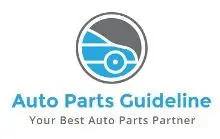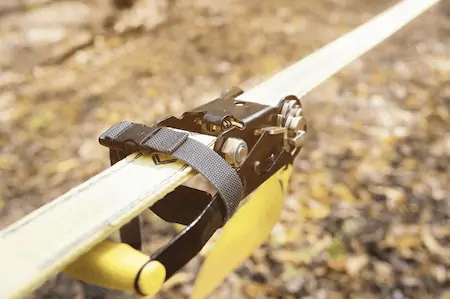Winches are necessary whenever you want to haul heavy loads or objects, especially if you’re using a vehicle to assist you. They are crucial when transporting a loaded cargo, dragging boats, or recovering a stuck truck in mud.
But what if you need to carry your heavy shipment on your truck without letting it fall off? In all likelihood, you’ll use a winch to get them moving, but will the winch prevent your loads from skidding off in transit?
In such situations, very few tools come handier than a winch strap. It keeps your load intact even when the truck is moving. And this article explains how to use a winch strap properly to get the most out of it.
What Is A Winch Strap?
A winch strap is a tool with a woven rope and a metal hook mainly used for securing cargo loads and similar industrial purposes. Nevertheless, it makes an excellent device for towing boats, trailers, trucks, and wrecked vehicles.
These tie-down straps keep heavy loads together by pulling them tight, holding them in place with tension. Polyester webbing is most commonly used to make winch straps, making them resilient and resistant to harsh weather conditions.
The Basics Of Using A Winch Strap
Winch straps may vary in size and hardware, but their usages share a few fundamental characteristics. Among those are:
- Spooling the Winch: You’ll want to let the winch spool free-flowing so you can pull out the winch strap as needed.
- Wrapping the Winch Strap: Wrap the strap around your load lengthwise, ensuring it doesn’t twist; if it does somehow, straighten it out.
- Anchoring the Winch Strap: Secure the winch strap to an anchor point.
- Locking the Winch: Keep the winch straps from spinning at will while it’s locked.
- Tightening the Winch Strap: Tighten the strap after installing the winch.
People complain most about the tightening part, especially when securing flatbed cargos with loads that are barely balanced.
However, following these simple steps will help reduce hassles regardless of the application.
- Begin by attaching the strap’s hook to D-ring hardware or a side rail.
- Pull the excess slack from the strap by feeding the free end into the winch.
- Adjust it to your desired position once the winch strap is on the load and start tightening it.
Now, if you’re using a winch, using a winch bar is the best way to make sure the strap is tight. And if you’re using a ratchet with a winch strap, only pump it until it’s fast enough.
Types Of Winch Strap Hardware To Work with
A winch strap can work with multiple types of hardware, which only adds to its versatility. Below are some popular options that can serve you on the road or in an industrial setting.
Wire Hook
In addition to being extremely durable, wire hooks are designed to fasten onto the other side of a flatbed trailer. But it also lets you secure your carload faster, so you’re back on the road more quickly.
Flat Hook
Flat Hooks are almost like wire hooks, but they’re flat and hook into place along the far side of a flatbed trailer.
The flat design can cover a wider surface area than wire hooks while maintaining similar durability. This hardware serves as a time saver for people who ship cargo often.
Chain And Hook
You can easily attach a chain and hook to one side of a strap. They work great for applications with heavy loads or odd shapes, where mounting points are harder to come by.
Forged Delta Ring
Forged D Rings are among the most popular winch straps and may be more suitable for drivers under certain conditions. Its lightweight tie-down webbing makes loading heavier loads easier since it requires less handling of any excess weight.
How To Use A Winch Strap To Secure Racheted Cargo
There’s no doubt that winch straps are most commonly used when ratcheting large cargo for loading or unloading industrial shipments. These straps can support a variety of weights and sizes of freight when used correctly.
The proper way to use a winch strap for ratcheting cargo is to thread it through the mandrel before cranking the ratchet and tightening it. Here’s how.
Thread The Winch Strap
- Open the ratchet by using the release catch. It consists of a hand-sized handle for disengaging the ratcheting handle, called the release catch or lever. You’ll find it centered in the ratchet’s top movable piece.
- To flip open the ratchet entirely, lift the release catch. Lay the wide-open ratchet out on a table with the spiked wheels facing up
- Thread the winch strap through the ratchet’s base. Ratchets hold the strap length in a slot at the bottom known as a mandrel.
- Push the ratchet upward through the mandrel starting from underneath. Afterward, the threaded strap should lie straight.
- As the strap goes through the mandrel, ensure it’s securely taut. However, you don’t need to stress about the length; you can tighten it later if necessary with the ratchet.
Secure Your Cargo
- Drag your cargo to the position you wish it to remain, then fasten the winch strap to it. Hook the ends over the truck bed’s side or in the van wall’s grooves.
- If you want to hold multiple objects together with the winch strap, like two large frames, simply wrap the strap around them and connect the ends. This way, you’ll make a solid and secure loop. However, this technique only binds items together; it doesn’t keep them in place.
- You will need two winch straps to secure multiple objects in place. Secure the items with one strap and wrap the other around them to keep them in place.
- Set the ratchet to the desired tension. Pull the ratchet back and forth until you get the ideal length to tighten the winch strap. Once your cargo feels snug around the straps, stop ratcheting.
- You should feel it being tight and secure when you tug the strap. However, do not overtighten your strap; else, your ratchet, cargo, or the strap itself may get damaged. You probably overtightened the strap if your finger couldn’t fit between it and the object.
- Secure the strap firmly by flipping the ratchet shut. Keep pressing until it latches. It means the strap is securely in place and will hold your cargo safely.
Release The Strap
- To release the lock, pull the release tab and hold it. You can easily access the release tab on the ratchet’s top.
- Loosen the strap by opening up the ratchet. Turn the ratchet down flat before pulling on the strap’s non-fixed side. Once you do this, you can entirely remove the strap from the ratchet.
- To close the ratchet again, pull the release tab and hold it. Thus, the ratchet is locked in place until you can use it once more.
How To Secure A Winch Strap On A Flatbed Trailer
Flatbed trailers use winch straps to secure the cargo on the trailer along the rub rails, generally above the shipment load.
As a cheaper alternative to chain-loaders over the long term, it’s also pretty straightforward to use.
- First, you place the wich straps over the top of the shipping cargo and latch them into place across from the trailer’s rub rail.
- You then tighten the straps using a winch bar as much as you need.
How To Use A Winch Strap On A Towing Trailer
Other than industrial uses, winching straps are most commonly used when loading downed vehicles onto a towing trailer.
However, such applications aren’t without increased risks for fatal injuries because of the involvement of heavy loads in a potentially risky situation.
So, before you operate the winch for towing, you must follow all safety procedures to prevent injury or damage. Here’s what you need to remember.
- Make sure the trailer is securely attached to the towing vehicle so it won’t roll away.
- When loading and unloading vehicles from a trailer, ensure the towing vehicle is parked with the handbrake engaged and the trailer is on a level surface.
- Pre-inspect the winch strap to ensure that it is not excessively worn or frayed.
- As a safety precaution, you may clamp the towing vehicle’s wheels if necessary.
- Standing behind a trailer while it’s getting winched onto a vehicle is risky, as the strap could come undone at any time.
Next, you will need to carry out these steps.
- Open the winch’s safety latch and then set it in the open position.
- Draw the winch strap up to the trailer ramps. (Keep an eye out for spinning handles.)
- Then attach the winch strap to the vehicle’s designated tow points.
- Turn the winch into the desired position by releasing the safety catch. You’ll hear a clicking sound as the winch winds.
- Ensure the winch strap is centered and load the vehicle in the middle of the trailer.
- If you want your operations to run smoothly, make sure nothing gets caught in the cogs.
How To Store A Winch Strap Between Uses
While winch straps are sturdy and durable, they can wear over time if not stored correctly.
Steer clear of areas affected by moisture or direct sunlight whenever you store winch straps. Mold can develop in your straps due to moisture accumulation, and UV rays can damage them if not correctly stored, requiring them to be replaced as soon as possible.
You can store these straps in a duffle bag, or a similar dry bag that you can keep in the back of your semi-truck or somewhere outside that isn’t prone to catch moisture.
Winch Starp FAQs
What Is The Maximum Length You Can Have On a Winch Strap?
Winch straps are commonly 27 feet or 30 feet long tie-down webbings that connect to the winch or ratchet. However, manufacturers or dealers can provide you with customized sizes to serve any need upon request.
Is A Winch Strap Just As Suitable As A Ratchet Strap For Above-Average Cargo Loads?
Yes, if the size and hardware are correct. Winch straps can even stand up as a more cost-effective alternative to ratchet straps as they don’t require the expensive hardware that ratchet straps need.
Can You Use A Ratchet Strap For Winching?
Yes, but not always. You can sure winch down small vehicles like motorcycles or minis with a ratchet strap but not oversized cars or cargo. For heavy vehicles like trucks, you need winch cable.
Can You Use A Winch Strap For Securing Hay?
Yes, you can, so long as you’re following the proper weight limit and using the correct wrapping.
Are Winch Straps Safer Than Chains?
Your application will determine the answer. When you’re towing your car, a winch strap is more flexible and safer than chains because of its lightweight and durability.
The same may not be applicable for loading larger loads in a shipyard.
Final Thoughts
Winch straps are somewhat indispensable when you’re transporting cargo, while they also come in handy by the roadside during emergencies. Their durability makes them ideal for securing larger loads for a long time.
Another reason they are popular is their affordability compared to chains and ratchet straps. And knowing how to use a winch strap allows you to install it on your own when the situation arises.


![Read more about the article Best Winch for Jeep [All Jeep Models | Top 10 Picks of 2022]](https://autopartsguideline.com/wp-content/uploads/2021/07/best-winch-for-Jeep-300x197.webp)
![Read more about the article How to Use a Winch [Step by Step Guide & Precautions]](https://autopartsguideline.com/wp-content/uploads/2021/10/how-to-use-a-winch-300x193.webp)
